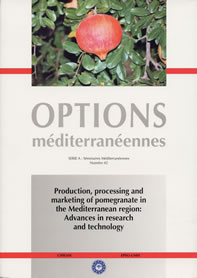| Article précédent | p. 93-97 | Article suivant |
Evolution of anthocyanin content of four pomegranate cultivars (Punica granatum L.) during fruit development
Anthocyanins are responsible for the external and interior colour of the pomegranate and the red colour is considered by consumers to be one of the main quality parameters. The aim of the present work is the analysis and quantification of the anthocyanin pigments in pomegranate juice during fruit development and ripening. The cultivars studied are ME5, ME17, MO6 and MA4. First, fruits were labelled in the same phenological stage at four orientations. Then anthocyanins were analysed quantitatively and qualitatively using HPLC. Anthocyanin evolution was studied in different tree orientations and results were subjected to a statistical analysis. A rise in amount of pigment was observed during fruit development and juice colour changed from colourless to dark red. During the earlier stages the diglycoside form was predominant (particularly 3,5-delphinidin) in all cultivars.
- [ Afficher ]
- [ Télécharger ]
- [ Exporter la citation ]
Vous pouvez télécharger la citation au format :
- [ Imprimer ]
-
Mots-clés
ANTHOCYANE, GRENADE FRUITS, MURISSAGE, PIGMENT, PUNICA GRANATUMCiter cet article
Legua P., Melgarejo P., Martínez M., Hernández F. Evolution of anthocyanin content of four pomegranate cultivars (Punica granatum L.) during fruit development. In : Melgarejo P. (ed.), Martínez-Nicolás J.J. (ed.), Martínez-Tomé J. (ed.). Production, processing and marketing of pomegranate in the Mediterranean region: Advances in research and technology. Zaragoza : CIHEAM, 2000. p. 93-97. (Options Méditerranéennes : Série A. Séminaires Méditerranéens; n. 42). Symposium on 'Production, processing and marketing of pomegranate in the Mediterranean region: Advances in research and technology', 1998/10/15-17, Orihuela (Spain). http://om.ciheam.org/om/pdf/a42/00600257.pdf



